

Obscure Model Puts a Price on Good Health—and Drives Down Drug Costs. The Belmont Report. The Belmont Report was written by the National Commission for the Protection of Human Subjects of Biomedical and Behavioral Research.
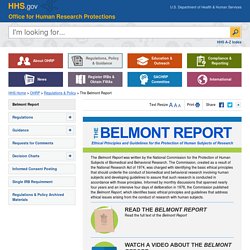
The Commission, created as a result of the National Research Act of 1974, was charged with identifying the basic ethical principles that should underlie the conduct of biomedical and behavioral research involving human subjects and developing guidelines to assure that such research is conducted in accordance with those principles. Informed by monthly discussions that spanned nearly four years and an intensive four days of deliberation in 1976, the Commission published the Belmont Report, which identifies basic ethical principles and guidelines that address ethical issues arising from the conduct of research with human subjects. Understanding the Drug Discovery Process – Compound Interest.
Drug testing was in the news on Friday – though this time it wasn’t the usual sports doping headlines, but instead news of the clinical trial of a drug gone tragically wrong in France.
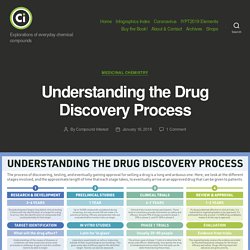
Of the 90 people given the drug in a phase 1 clinical trial, one has been left with permanent brain damage, and another five are still hospitalised. What is a phase 1 clinical trial? That’s what this graphic aims to explain, as well as outlining the whole drug discovery process. As a consumer, it’s easy to be oblivious to the amount of time, work, and money that goes into the development of a drug.
The cost of developing a drug that goes on to gain marketing approval was estimated to be $2,558 million in 2014, and the process can commonly last longer than a decade. White Paper: Pragmatic Randomized Trials: Considerations for Design and Implementation - Evidera. One of the challenges of designing effective PRTs is the choice of outcomes and endpoints.

The term outcome is used here to mean a measured variable or event of interest (e.g., time to first occurrence of a composite outcome such as myocardial infarction [MI], stroke, or cardiovascular death, which collectively are referred to as major adverse cardiovascular events [MACE]), whereas an endpoint refers to an analyzed parameter that is expected to change over time as a result of an intervention (e.g., change in LDL-C from baseline). For a PRT to meet the requirements of both regulators and payers, it is important that the selected endpoints and outcome measures resonate with key stakeholders (patients, payers, regulators, and healthcare providers), and be defined with sufficient sensitivity (typically more important for safety) and specificity (typically more important for effectiveness estimates) to translate the trial objectives into precise definitions of treatment effect.
The biopharmaceutics risk assessment roadmap for optimizing clinical drug product performance. Physiologically based pharmacokinetic modeling in drug discovery and development: a pharmaceutical industry perspective. Improving safety of first-in-human clinical trials. Optimal Decision Criteria for the Study Design and Sample Size of a Biomarker-Driven Phase III Trial. Appendix 1: Formulation of PoS The PoS of the traditional and enriched designs is formulated as follows, using the predicted distribution of treatment effect in each population of equation (1).
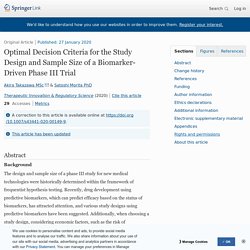
The PoS of the stratified and adaptive enrichment designs is calculated by simulations. The PoS in these study designs is represented as follows based on the study success criteria in each design mentioned above. Home - European Patients Academy on Therapeutic Innovation. How and Why to Involve Patients in Drug Development: Perspectives From the Pharmaceutical Industry, Regulatory Authorities, and Patient Organizations. Background: Despite increasing interest and focus on patient-centric approaches to drug development, there might still be divergent views between key stakeholders in how to perceive patient involvement and how possibly divergent views influence the role of patients in the drug development process.
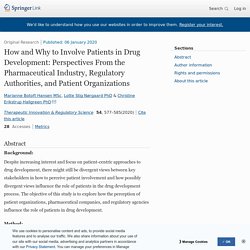
The objective of this study is to explore how the perception of patient organizations, pharmaceutical companies, and regulatory agencies influence the role of patients in drug development. Method: A qualitative interview study based on 12 semi-structured interviews with representatives from the 3 stakeholders. Interviews were transcribed, and data were analyzed using a social constructivist approach in the form of systematic text condensation.
Patient Preference Studies During Early Drug Development: Aligning Stakeholders to Ensure Development Plans Meet Patient Needs. Introduction Pharmaceutical companies are increasingly recognizing the value of incorporating the patients' perspectives into the clinical development process to deliver treatments and outcomes that are relevant to them.
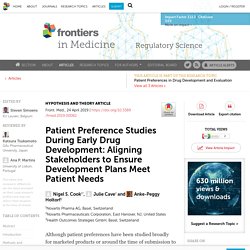
Traditionally, clinical development has been weighted toward clinically held beliefs of what is important to patients, with the patients' perspective being captured only during the later stages of development either via patient reported outcomes (PROs) or anecdotal evidence. Recent evidence suggests that even in well-studied diseases, clinically held beliefs of what is important to patients may differ from the needs expressed by patients themselves (1, 2). 42261dft5 12 16. Use of Big Data to Aid Patient Recruitment for Clinical Trials Involving Biosimilars and Rare Diseases. 1.The Center for Biosimilars Staff.
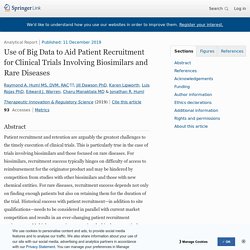
Infographic: biosimilars and rare diseases. 28 Feb 2019.2.The Center for Biosimilars Staff. Russian drug maker gains world’s first approval for biosimilar eculizumab. 11 Apr 2019.3.Huml RA, Dean M. Designing effective rare disease registries. Real-World Data Playing a Bigger Role in Drug Development. WASHINGTON -- Changes in the way data are being collected are on track to revolutionize the use of real-world data in drug approvals, Janet Woodcock MD, the longtime director of the FDA's Center for Drug Evaluation and Research, said here.

Traditional vs. Pragmatic: Changing the Trial Model with Real-World Evidence. Studies based on real-world evidence (RWE) don’t have to be a replacement for randomized clinical trials but rather an integral part of an overall trial strategy.

Both pragmatic and randomized trials have their pros and cons, but when combined they can produce more effective results. “I think using both of these to provide evidence to the regulators will be where we go in the future,” said Francis Kendall, senior director at Cytel. You could conduct one or two small phase 1 or 2 trials to show safety and efficacy, he suggested, then apply machine learning and analytics to data on the full targeted population to confirm results. Masking in Pragmatic Trials: Who, What, and When to Blind. Masking (or blinding) of treatment assignment is routinely implemented in classical randomized clinical trials (RCTs) to isolate the effect of the intervention itself and to minimize the potential for bias that could occur with traditional trials.
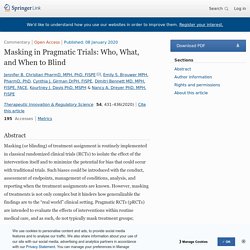
Such biases could be introduced with the conduct, assessment of endpoints, management of conditions, analysis, and reporting when the treatment assignments are known. However, masking of treatments is not only complex but it hinders how generalizable the findings are to the “real world” clinical setting. Pragmatic RCTs (pRCTs) are intended to evaluate the effects of interventions within routine medical care, and as such, do not typically mask treatment groups; moreover, pRCTs assess comparators that are available in routine medical practice, not masked placebos.
Whether pRCTs should be masked if intended for regulatory or other purposes has recently been questioned. Changing R&D models in research-based pharmaceutical companies. Eli Lilly is a pioneer and leader in the crowdsourcing field in the pharmaceutical industry. It initiated several crowdsourcing initiatives such as Innocentive® or YourEncore- both are now operated independently. YourEncore (www.yourencore.com) is an expert network working in technology industry, such as life science, consumer and food industries, that support companies to access expert know-how to help to solve the companies’ problems. Fields of expertise in the pharmaceutical industry are preclinical and clinical development, clinical operations, manufacturing, regulatory affairs, organizational effectiveness, safety, pharmacovigilance, and quality management. Innocentive® (www.innocentive.com) is a global network of more than 365,000 registered problem solvers coming from about 200 countries and problem-posting companies, such as AstraZeneca, Eli Lilly, NASA, Procter & Gamble, Syngenta, have partnered with InnoCentive® to get innovative ideas provided.
Smart Pharma: How Technology is Disrupting the Pharmaceutical Industry. New technologies such as big data and AI are revolutionising the pharmaceutical industry. It’s a top-to-toe disruption affecting everything from patient interaction with the health system, to how they are treated. Because these changes are so radical and so all-encompassing, it’s a major challenge for pharma companies to keep pace. Not only is innovation happening but it’s happening incredibly quickly. With its cumbersome operational base and restrictive regulatory environment, large pharma is struggling to keep up. New, more nimble pharmaceutical startups are managing to encroach on the established industry landscape, disrupting the competition.
New technologies that are likely to be disruptive include 3D printing, which can be used to customise everything from drugs to prosthetics, and artificial intelligence – both of which are changing the way new drugs are developed. RELATED: Consumer Tech Giants Disrupting the Healthcare Sector Pharmacovigilance Science fiction Disrupting relationships. Estimating the clinical cost of drug development for orphan versus non-orphan drugs. In this study, we utilized publicly available clinical trial data to determine any differences in trial characteristics between non-orphan and orphan drugs; these data were then used to calculate the out-of-pocket and capitalized clinical cost of drug development for orphan and non-orphan drugs. Our analysis shows that the out-of-pocket costs per approved orphan drug is about 60% the cost for approved non-orphan drugs. Also, the capitalized costs per approved orphan drug is about 70% of the cost for their non-orphan counterparts.
When focusing on NMEs alone, the capitalized cost per approved orphan drug was half that of a non-orphan drug. A review of rare disease policies and orphan drug reimbursement systems in 12 Eurasian countries. Marcin Czech1, 2, Aleksandra Baran-Kooiker3*, Kagan Atikeler4, 5, Maria Demirtshyan6, Kamilla Gaitova7, Malwina Holownia-Voloskova88, 9, Applications of machine learning in drug discovery and development. New drug candidate created by AI in ‘world first’ Pharma's AlphaGo Moment: For the First Time AI Has Designed and Validated a New Drug Candidate in Days. Do androids dream of electric lawsuits? Current IP law ill-suited for AI in drug discovery, panelist says. L-R: Richard Assmus, David Opderbeck, Lori Bennett, Brian Nolan. What is VPH institute? Virtual Physiological Human Institute is an international non-profit organisation.
Glossary of clinical research - Wikipedia. From Wikipedia, the free encyclopedia. Clinical Research Acronyms and Abbreviations You Should Know. Modernization. A type of eligibility criteria that indicates whether people who do not have the condition/disease being studied can participate in that clinical study.An arm type in which a group of participants receives an intervention/treatment considered to be effective (or active) by health care providers.An unfavorable change in the health of a participant, including abnormal laboratory findings, that happens during a clinical study or within a certain amount of time after the study has ended.
This change may or may not be caused by the intervention/treatment being studied.A type of eligibility criteria that indicates the age a person must be to participate in a clinical study. This may be indicated by a specific age or the following age groups:The age groups are: Child (birth-17)Adult (18-64)Older Adult (65+)A measure of all deaths, due to any cause, that occur during a clinical study.A method used to assign participants to an arm of a clinical study. Home - CIAP Clinical Information Access Portal. Developing the Clarity and Openness in Reporting: E3-based (CORE) Reference user manual for creation of clinical study reports in the era of clinical trial transparency. Broad principles. Consort - Welcome to the CONSORT Website. Clinical Trial Data Transparency. Responsible data-sharing for clinical trials - Health Report. Norman Swan: So how do you organise access to this data in a reliable, predictable way?
Well, in the United States, where a significant proportion of the world's pharmaceutical industry resides, the Institute of Medicine has recently tried to formalise this access to raw data on medications right down to individual patient experiences. Compliance with legal requirement to report clinical trial results on ClinicalTrials.gov: a cohort study - The Lancet. Universities are worse than drug companies at reporting clinical trial results.
2020 international compilation of human research standards. Problematica. Twist baby twist. Test Test Goose. Intervention.ally. Mad Med Mice, See how they ... Rousting. Substantia. Robust. PharmMed Intro2. Pharma.